FIAT 500E 2019 Owner's Manual
Manufacturer: FIAT, Model Year: 2019, Model line: 500E, Model: FIAT 500E 2019Pages: 300, PDF Size: 3.03 MB
Page 21 of 300

E-Park is activated when the driver pushes the PARK
button. An electric motor activates the parking pawl and
locks the single-speed transmission when the vehicle is
placed into PARK. This will prevent any unwanted move-
ment of the vehicle.
NOTE:The engagement of the E-Park can be heard when
there is no noise in the interior of the vehicle, this is a
normal condition.
Climate Control (HVAC System)
Your 500e is equipped with an Automatic Temperature
Control (ATC) HVAC system. This HVAC system utilizes a
humidity sensor, cabin sensor, and ambient temperature
sensor to choose operation mode and control cabin com-
fort. These components allow the controller to operate the
HVAC system in a very efficient manner to maximize
driving range.
Your 500e also uses an electric air heater to provide heat to
the cabin.
Electric Air Conditioning Compressor
Your 500e uses an electric air conditioning compressor. The
air conditioning compressor is powered by the high volt-
age battery system and is used to cool the vehicle occu-
pants and the high voltage battery while the vehicle is
being driven or when it is being charged.
The high voltage battery may require cooling to keep the
vehicle running. The air conditioning compressor activates
without any input from the occupant.
NOTE: The AC system helps cool the high voltage battery.
If the air conditioning system should require service, see an
authorized dealer as soon as possible.
Electric Power Steering
Your vehicle is equipped with an Electric Power Steering
(EPS) system. The power steering system requires no
maintenance and operates without the use of power steer-
ing fluid.
3
GETTING TO KNOW YOUR VEHICLE 19
Page 22 of 300
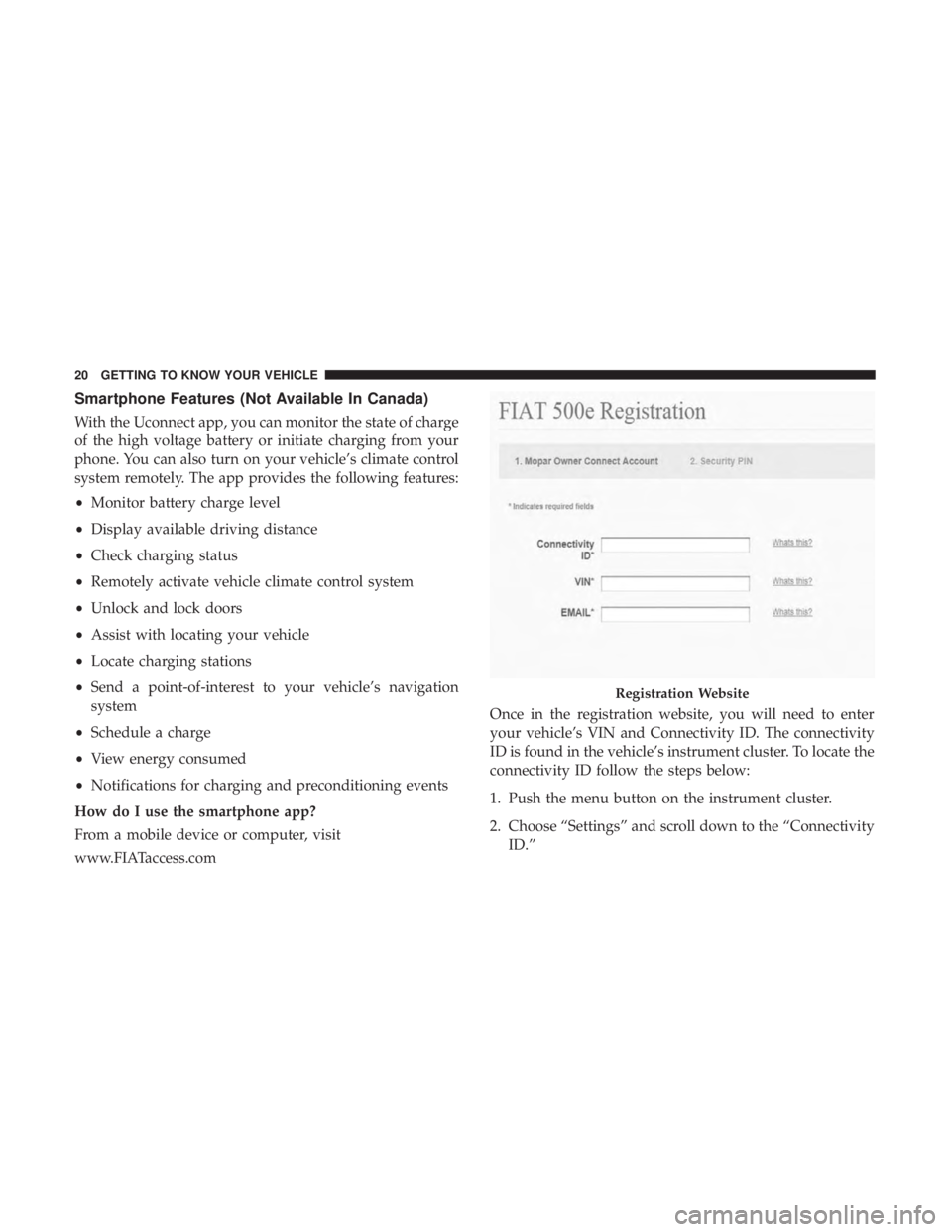
Smartphone Features (Not Available In Canada)
With the Uconnect app, you can monitor the state of charge
of the high voltage battery or initiate charging from your
phone. You can also turn on your vehicle’s climate control
system remotely. The app provides the following features:
•Monitor battery charge level
• Display available driving distance
• Check charging status
• Remotely activate vehicle climate control system
• Unlock and lock doors
• Assist with locating your vehicle
• Locate charging stations
• Send a point-of-interest to your vehicle’s navigation
system
• Schedule a charge
• View energy consumed
• Notifications for charging and preconditioning events
How do I use the smartphone app?
From a mobile device or computer, visit
www.FIATaccess.com Once in the registration website, you will need to enter
your vehicle’s VIN and Connectivity ID. The connectivity
ID is found in the vehicle’s instrument cluster. To locate the
connectivity ID follow the steps below:
1. Push the menu button on the instrument cluster.
2. Choose “Settings” and scroll down to the “Connectivity
ID.”
Registration Website
20 GETTING TO KNOW YOUR VEHICLE
Page 23 of 300

3. Select “Connectivity ID.”
After obtaining the connectivity ID and VIN number
return to the vehicle registration website and perform the
following:
1. After entering the VIN (Vehicle Identification Number),Connectivity ID and your email address, click “submit.”
2. You will now be asked to fill in your contact information and a user name and password.
3. Once finished with registration you will be directed to your 500e owner ’s site.
4. From your smartphone, search for and download the Uconnect App from the App Store (Apple iPhone) or
Google Play (Android mobile device).
5. To log in, use the username and password you used during registration. NOTE:
You must register with Uconnect Access to use the
services. Uconnect Access services are operable only for
36–months beginning on the date of the retail sale of the
500e. At the end of the 36–month operability period, the
services will be deactivated and will become inoperable,
and the services will be unavailable. The 36–month oper-
ability period cannot be extended, renewed or restarted
under any circumstances. Services can only be used where
3G cellular coverage is available, visit DriveUconnect.com
to view the coverage map.
Need help with registration?
Please call the Uconnect Call Center Toll Free number
below:1-855-261-5364
3
GETTING TO KNOW YOUR VEHICLE 21
Page 24 of 300
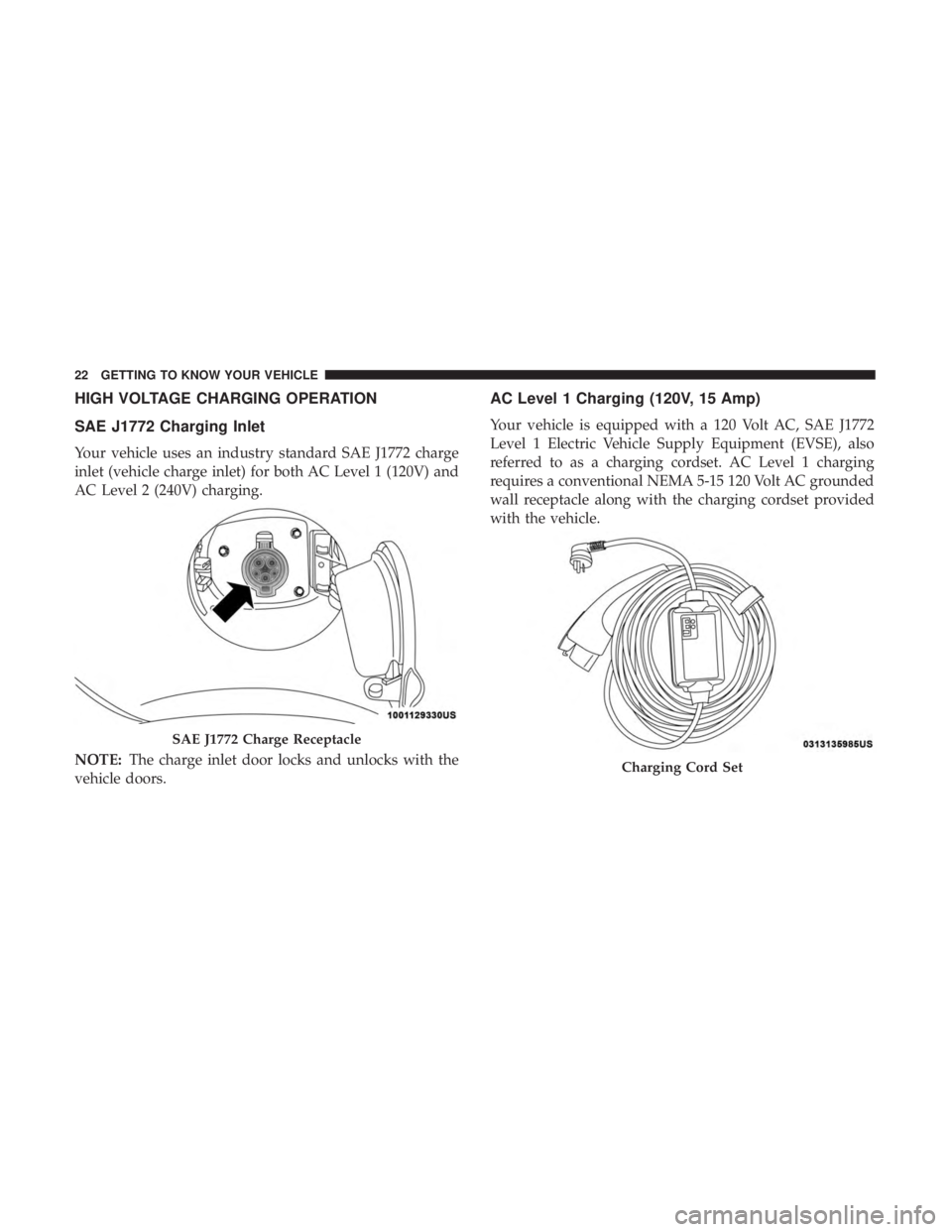
HIGH VOLTAGE CHARGING OPERATION
SAE J1772 Charging Inlet
Your vehicle uses an industry standard SAE J1772 charge
inlet (vehicle charge inlet) for both AC Level 1 (120V) and
AC Level 2 (240V) charging.
NOTE:The charge inlet door locks and unlocks with the
vehicle doors.
AC Level 1 Charging (120V, 15 Amp)
Your vehicle is equipped with a 120 Volt AC, SAE J1772
Level 1 Electric Vehicle Supply Equipment (EVSE), also
referred to as a charging cordset. AC Level 1 charging
requires a conventional NEMA 5-15 120 Volt AC grounded
wall receptacle along with the charging cordset provided
with the vehicle.
SAE J1772 Charge Receptacle
Charging Cord Set
22 GETTING TO KNOW YOUR VEHICLE
Page 25 of 300
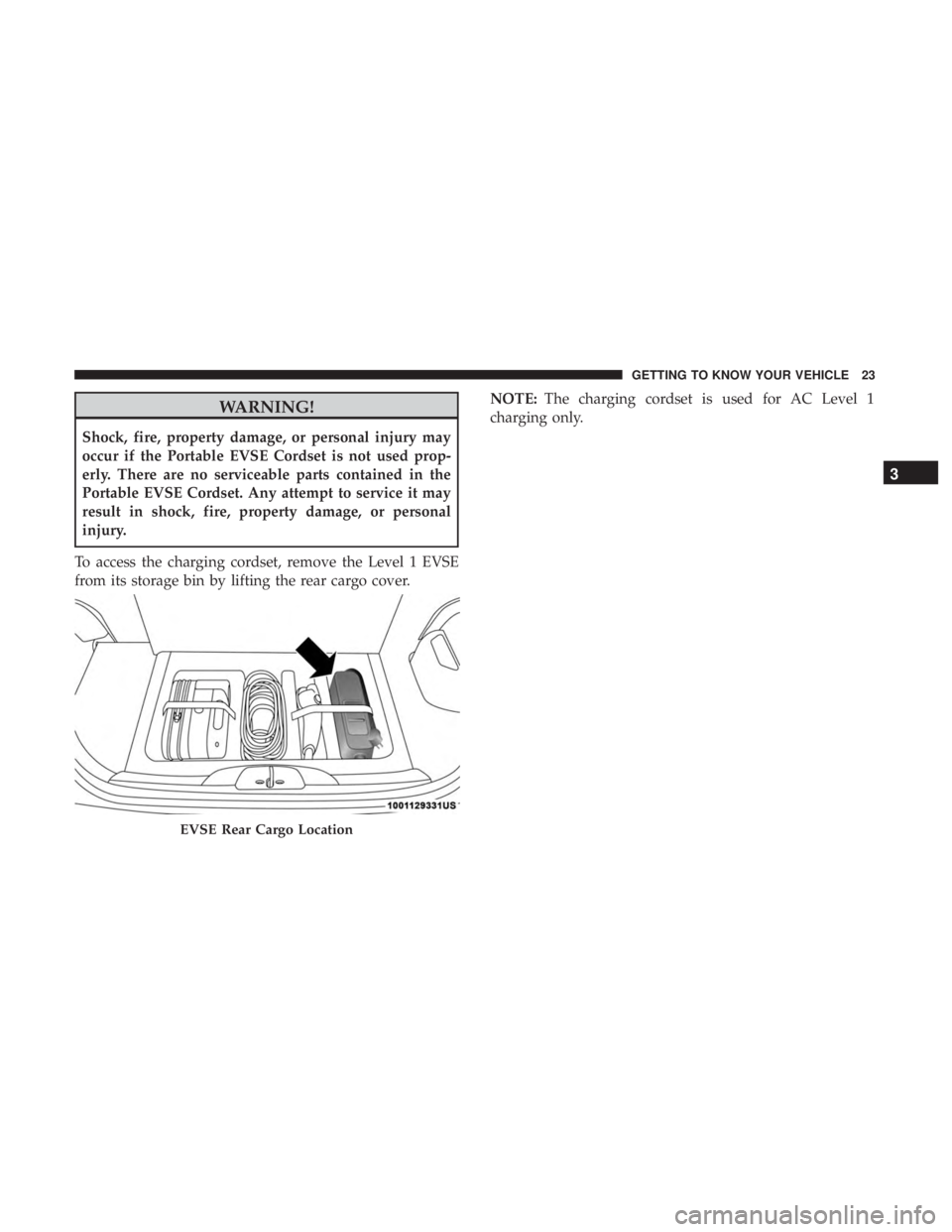
WARNING!
Shock, fire, property damage, or personal injury may
occur if the Portable EVSE Cordset is not used prop-
erly. There are no serviceable parts contained in the
Portable EVSE Cordset. Any attempt to service it may
result in shock, fire, property damage, or personal
injury.
To access the charging cordset, remove the Level 1 EVSE
from its storage bin by lifting the rear cargo cover. NOTE:
The charging cordset is used for AC Level 1
charging only.
EVSE Rear Cargo Location
3
GETTING TO KNOW YOUR VEHICLE 23
Page 26 of 300
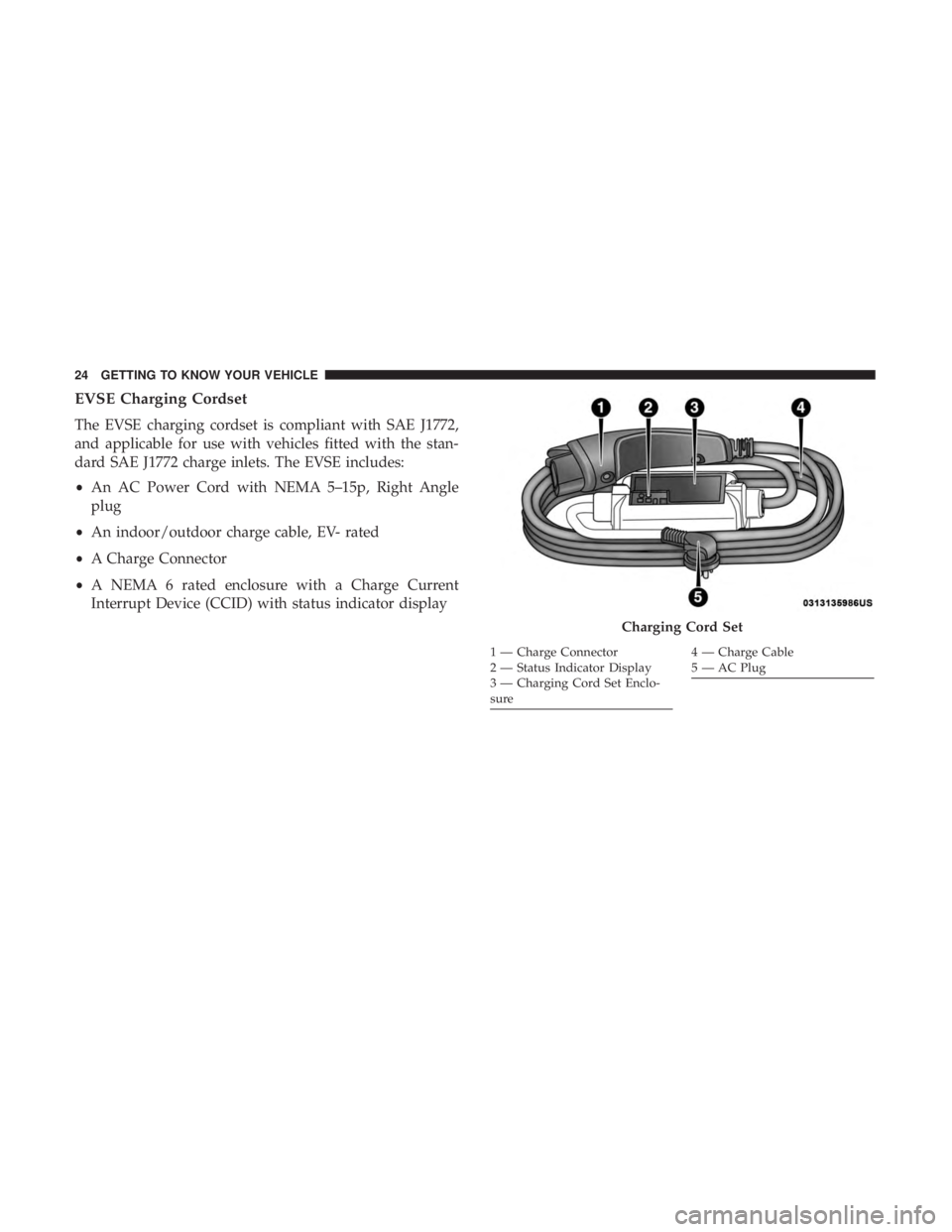
EVSE Charging Cordset
The EVSE charging cordset is compliant with SAE J1772,
and applicable for use with vehicles fitted with the stan-
dard SAE J1772 charge inlets. The EVSE includes:
•An AC Power Cord with NEMA 5–15p, Right Angle
plug
• An indoor/outdoor charge cable, EV- rated
• A Charge Connector
• A NEMA 6 rated enclosure with a Charge Current
Interrupt Device (CCID) with status indicator display
Charging Cord Set
1 — Charge Connector
2 — Status Indicator Display
3 — Charging Cord Set Enclo-
sure4—ChargeCable
5 — AC Plug
24 GETTING TO KNOW YOUR VEHICLE
Page 27 of 300
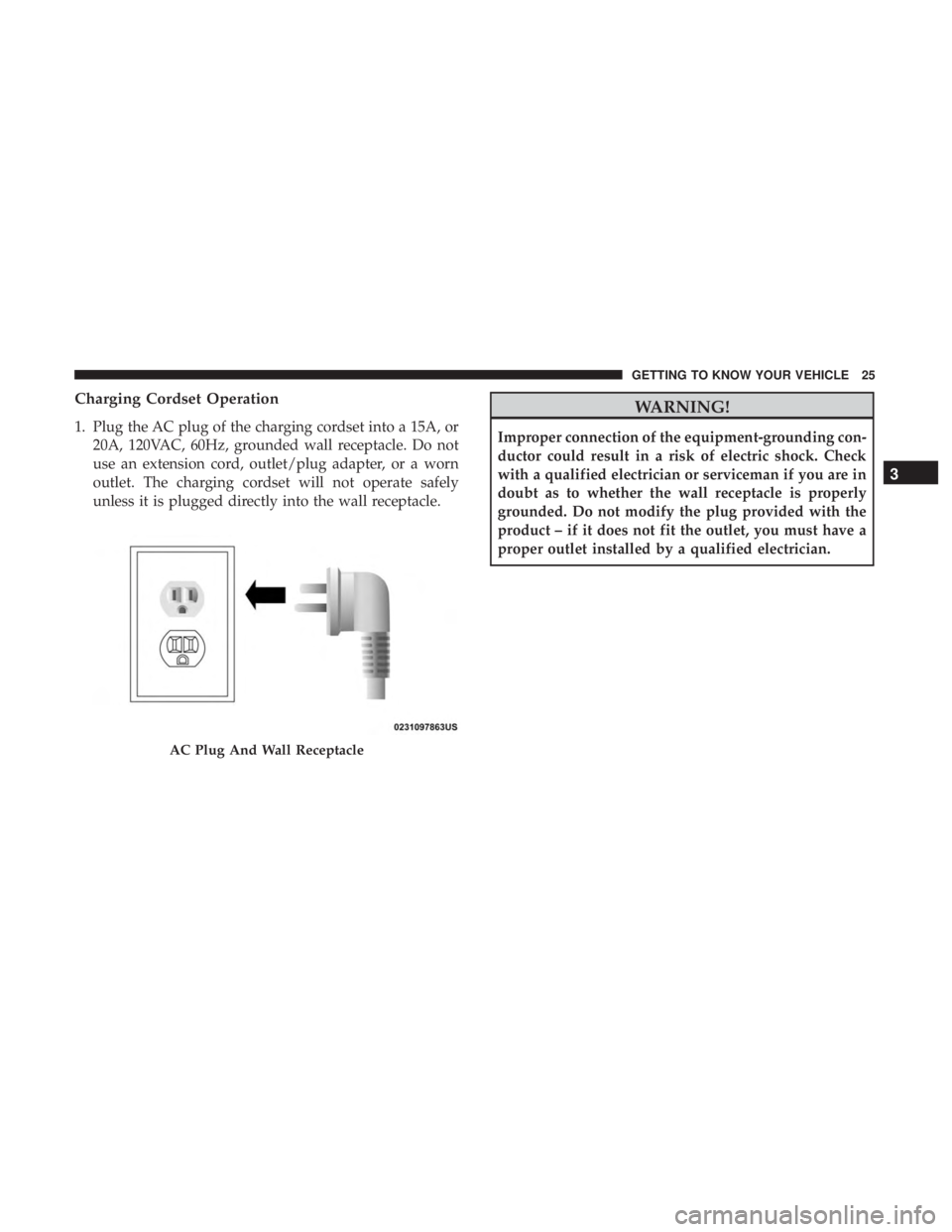
Charging Cordset Operation
1. Plug the AC plug of the charging cordset into a 15A, or20A, 120VAC, 60Hz, grounded wall receptacle. Do not
use an extension cord, outlet/plug adapter, or a worn
outlet. The charging cordset will not operate safely
unless it is plugged directly into the wall receptacle.
WARNING!
Improper connection of the equipment-grounding con-
ductor could result in a risk of electric shock. Check
with a qualified electrician or serviceman if you are in
doubt as to whether the wall receptacle is properly
grounded. Do not modify the plug provided with the
product – if it does not fit the outlet, you must have a
proper outlet installed by a qualified electrician.
AC Plug And Wall Receptacle
3
GETTING TO KNOW YOUR VEHICLE 25
Page 28 of 300
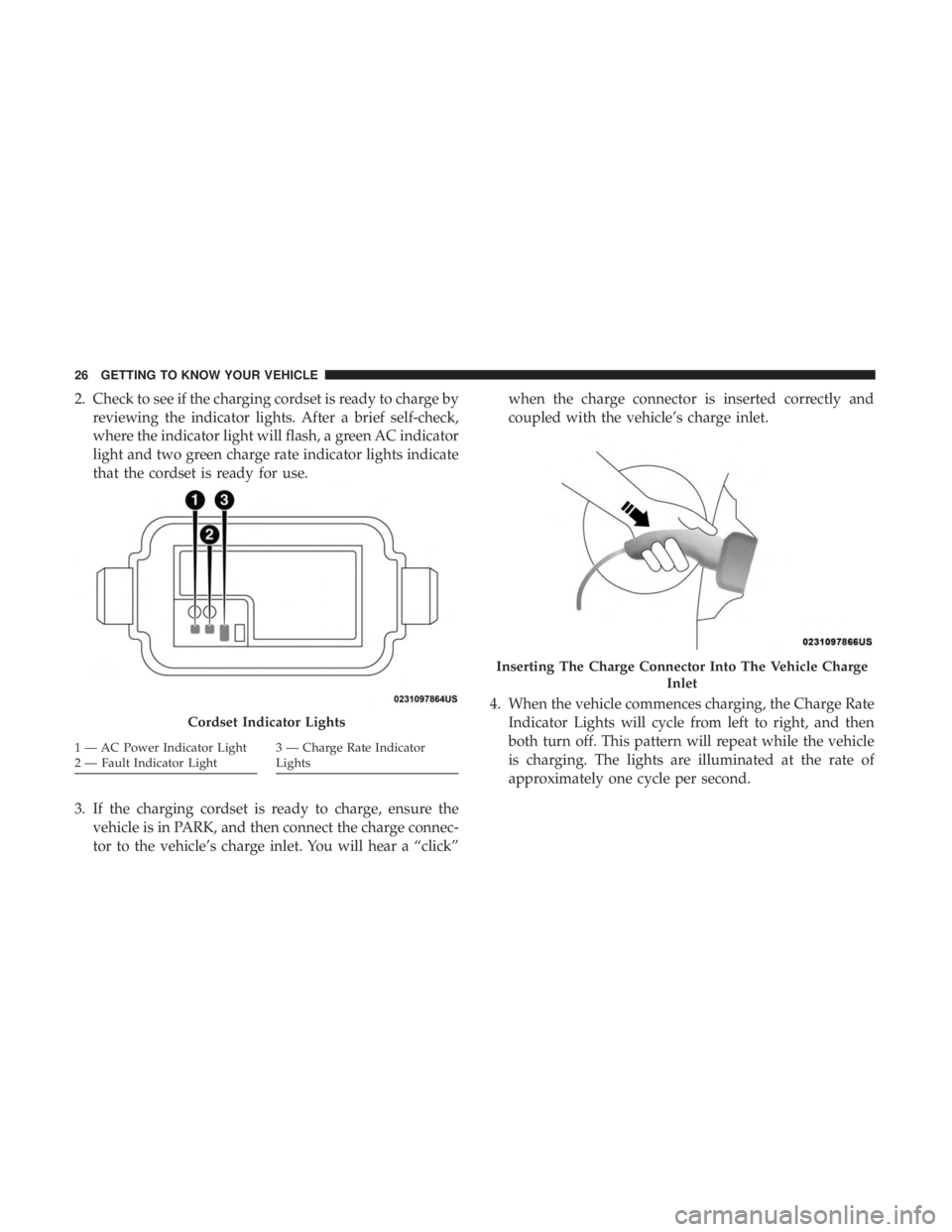
2. Check to see if the charging cordset is ready to charge byreviewing the indicator lights. After a brief self-check,
where the indicator light will flash, a green AC indicator
light and two green charge rate indicator lights indicate
that the cordset is ready for use.
3. If the charging cordset is ready to charge, ensure the vehicle is in PARK, and then connect the charge connec-
tor to the vehicle’s charge inlet. You will hear a “click” when the charge connector is inserted correctly and
coupled with the vehicle’s charge inlet.
4. When the vehicle commences charging, the Charge Rate Indicator Lights will cycle from left to right, and then
both turn off. This pattern will repeat while the vehicle
is charging. The lights are illuminated at the rate of
approximately one cycle per second.
Cordset Indicator Lights
1 — AC Power Indicator Light
2 — Fault Indicator Light3 — Charge Rate Indicator
Lights
Inserting The Charge Connector Into The Vehicle Charge
Inlet
26 GETTING TO KNOW YOUR VEHICLE
Page 29 of 300
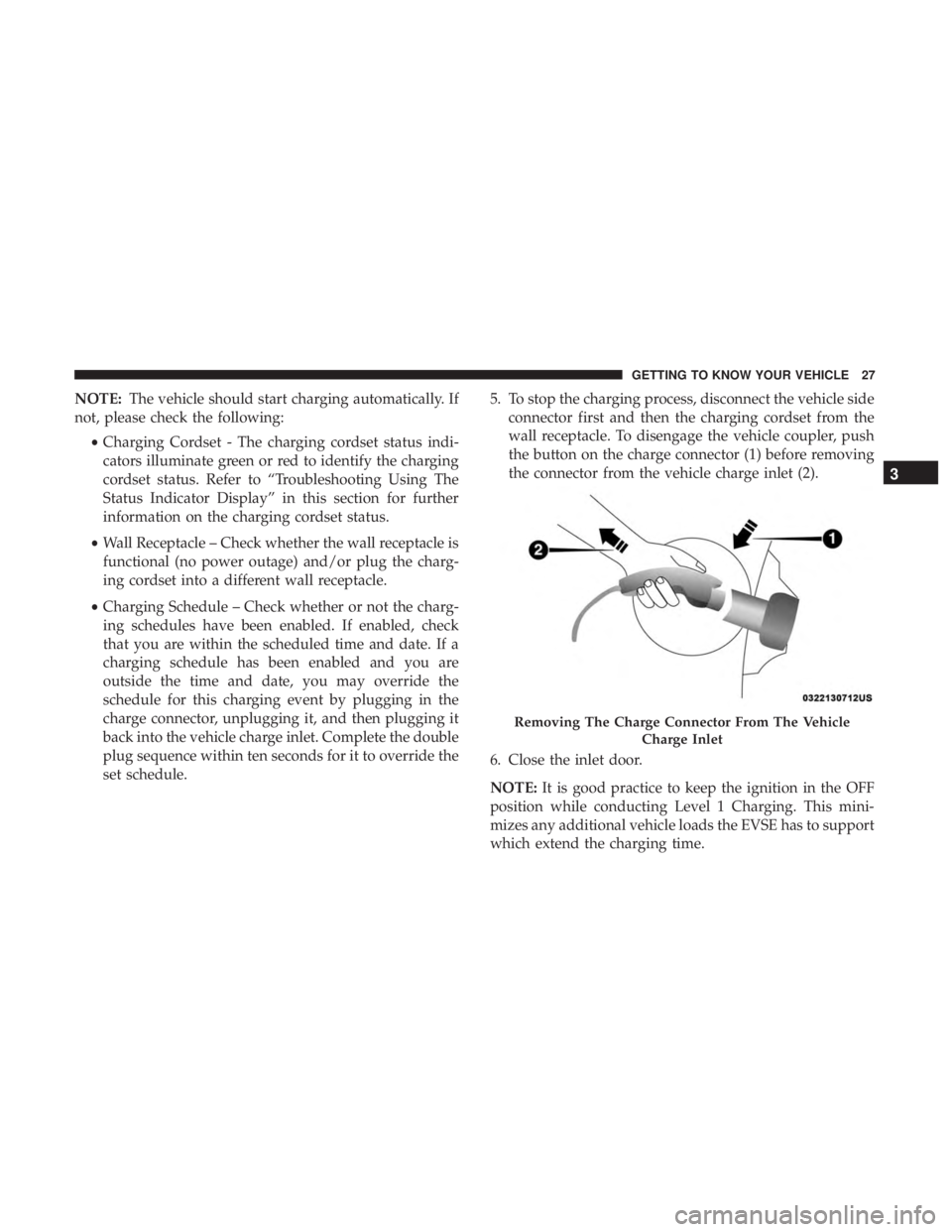
NOTE:The vehicle should start charging automatically. If
not, please check the following:
•Charging Cordset - The charging cordset status indi-
cators illuminate green or red to identify the charging
cordset status. Refer to “Troubleshooting Using The
Status Indicator Display” in this section for further
information on the charging cordset status.
• Wall Receptacle – Check whether the wall receptacle is
functional (no power outage) and/or plug the charg-
ing cordset into a different wall receptacle.
• Charging Schedule – Check whether or not the charg-
ing schedules have been enabled. If enabled, check
that you are within the scheduled time and date. If a
charging schedule has been enabled and you are
outside the time and date, you may override the
schedule for this charging event by plugging in the
charge connector, unplugging it, and then plugging it
back into the vehicle charge inlet. Complete the double
plug sequence within ten seconds for it to override the
set schedule. 5. To stop the charging process, disconnect the vehicle side
connector first and then the charging cordset from the
wall receptacle. To disengage the vehicle coupler, push
the button on the charge connector (1) before removing
the connector from the vehicle charge inlet (2).
6. Close the inlet door.
NOTE: It is good practice to keep the ignition in the OFF
position while conducting Level 1 Charging. This mini-
mizes any additional vehicle loads the EVSE has to support
which extend the charging time.
Removing The Charge Connector From The Vehicle
Charge Inlet
3
GETTING TO KNOW YOUR VEHICLE 27
Page 30 of 300

Troubleshooting Using The Status Indicator Display
If the vehicle is not charging properly, consult the status
indicator lights.
TheAC Power Indicator displays the status and safety of
the input power. If this indicator is green, the power is
within acceptable limits to charge the vehicle. If only the
AC Power Indicator is flashing red, then there is a problem
with the AC power at the electrical outlet. If the AC Power
Indicator does not return to green, then the outlet should
be inspected by a licensed electrician to ensure the voltage,
frequency, and grounding are complaint to national and
local electrical codes and ordinances. It may be possible to
attempt charging from a different outlet.
The Fault Indicator displays the status of the Portable
EVSE Cordset and the vehicle connection. The Portable
EVSE Cordset will not allow charging while the fault
indicator is red. If it is off, the Portable EVSE Cordset has
not detected any internal faults, or faults with the vehicle
connection. If the Fault Indicator is flashing red, there is a
fault detected either with the Portable EVSE Cordset,
electronics, or with the vehicle connection. The Portable
EVSE Cordset may attempt to retry to provide current to
the vehicle if the fault is cleared. If the Fault Indicator does not attempt to provide charge to the vehicle, the charge
connector will need to be removed from the vehicle to clear
the fault.
The fault code list in the table below provides a reference
for the important faults that are detected by the Portable
EVSE Cordset. When a fault is detected, the AC Power
Indicator, the Fault Indicator, or both the AC Power and
Fault Indicators will flash red. If only the AC Power
Indicator is red, there is a problem on the AC Power side of
the unit. If only the Fault Indicator is flashing red, there is
a problem internal to the unit or with the vehicle. If both
the AC Power and Fault Indicators are flashing red, an over
temperature condition is detected at either the AC plug or
within the enclosure. Additional information about the
faults is provided by a fault code that is displayed on the
two green Charge Rate Indicators. The fault code consists
of four digits, each with a value of 1 or 2. The value of a
digit is the number of indicators illuminated for that part of
the sequence. For example, fault code (1, 2, 1, 1) will
display the following sequence: One indicator will illumi-
nate for (0.3 seconds), then two indicators will illuminate,
then one indicator, and finally one indicator will illumi-
nate. After all four fault code digits have been displayed,
the indicators will remain off for one second before repeat-
ing the sequence.
28 GETTING TO KNOW YOUR VEHICLE